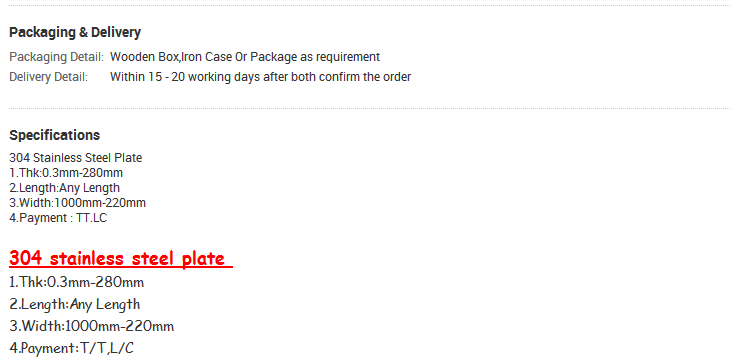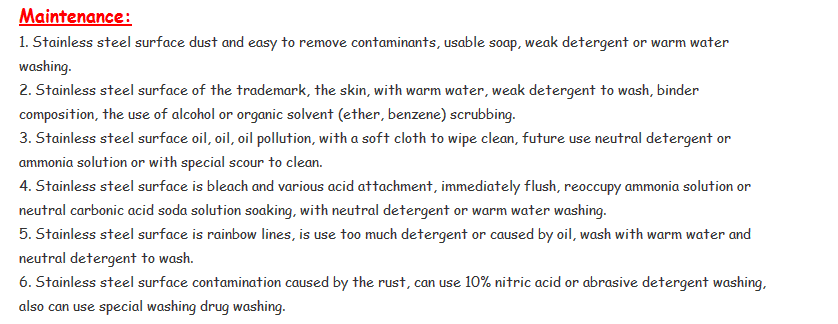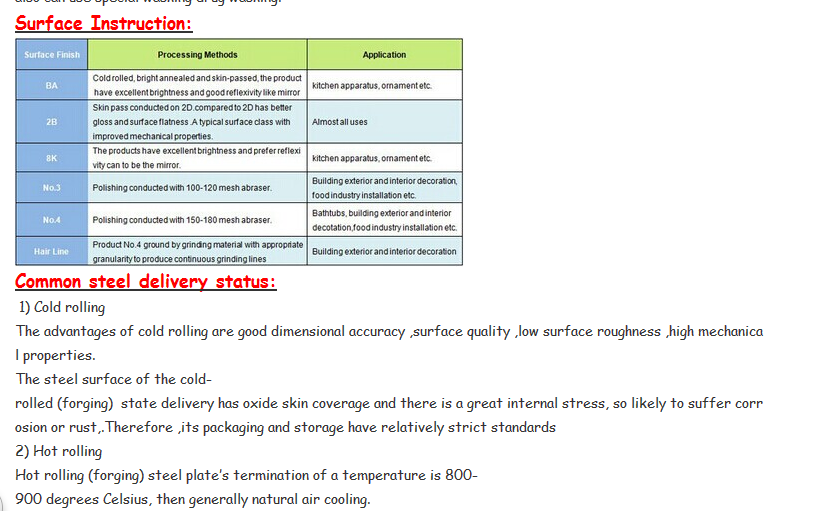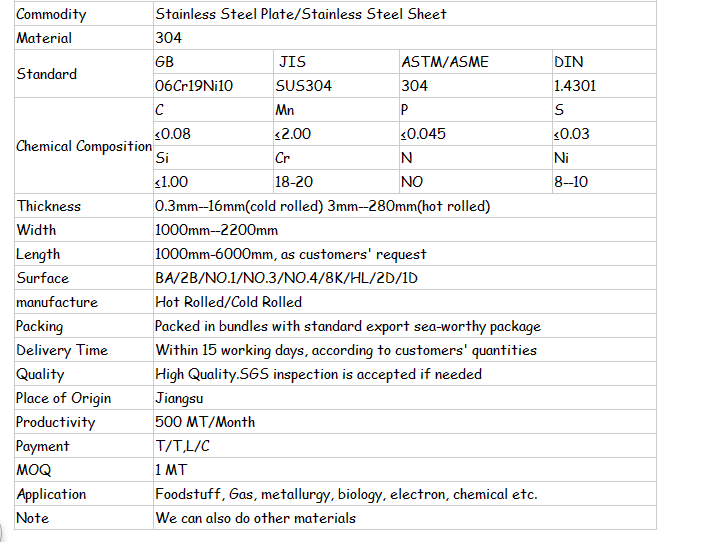American Standard ASTM A240 304 Stainless Steel Plate
- Loading Port:
- Tianjin
- Payment Terms:
- TT OR LC
- Min Order Qty:
- 100 kg
- Supply Capability:
- 1000 kg/month
OKorder Service Pledge
Quality Product, Order Online Tracking, Timely Delivery
OKorder Financial Service
Credit Rating, Credit Services, Credit Purchasing
You Might Also Like




- Q:Can stainless steel pipes be painted or coated?
- Indeed, it is possible to paint or coat stainless steel pipes. However, it is vital to opt for a suitable paint or coating specifically formulated for stainless steel surfaces. This is because stainless steel possesses a smooth and non-porous surface, which can pose a challenge for proper adherence of paint or coatings. Moreover, stainless steel pipes may encounter harsh environmental conditions, such as elevated temperatures or corrosive substances, thus necessitating the use of a paint or coating that is resistant to these elements. By selecting the appropriate paint or coating and employing correct surface preparation techniques, one can effectively enhance the appearance of stainless steel pipes or provide them with added protection against corrosion.
- Q:What are the advantages of using stainless steel pipes in the automotive industry?
- Stainless steel pipes offer numerous benefits when utilized in the automotive industry. Firstly, their exceptional resistance to corrosion ensures long-lasting durability. This is especially crucial in vehicles exposed to diverse environmental conditions, such as rain, snow, and road salt. By incorporating stainless steel pipes, manufacturers can guarantee that the exhaust system and other components remain in optimal condition for an extended period. Secondly, stainless steel pipes exhibit remarkable resistance to high temperatures. They can endure the extreme heat generated by the engine and exhaust system without corroding or deforming. Consequently, they are suitable for various vehicle parts, including exhaust manifolds, catalytic converters, and mufflers. Moreover, stainless steel pipes possess superior strength and impact resistance. They can withstand intense vibrations and shocks experienced during vehicle operation. This is vital for preserving the structural integrity of the vehicle and preventing potential failures or leaks. Additionally, stainless steel pipes offer excellent formability, enabling easy shaping and fabrication into complex designs. This versatility makes them suitable for various automotive applications, such as fuel lines, coolant systems, and hydraulic systems. Their malleability also reduces the requirement for additional components, resulting in cost savings during the manufacturing process. Furthermore, stainless steel pipes enhance the aesthetic appeal of vehicles. They provide a sleek and polished appearance that elevates the overall design. This is particularly significant for luxury vehicles and sports cars, where visual appeal plays a substantial role in attracting customers. Lastly, stainless steel pipes are environmentally friendly. They possess high scrap value and can be recycled without compromising quality. This promotes sustainability and reduces the demand for new raw materials, making them an eco-friendly choice for the automotive industry. In conclusion, the utilization of stainless steel pipes in the automotive industry offers advantages such as corrosion resistance, high-temperature resistance, strength and impact resistance, formability, aesthetic appeal, and environmental sustainability. These benefits establish stainless steel pipes as the preferred choice for various applications, contributing to the overall reliability and performance of vehicles.
- Q:Mechanical properties of stainless steel tubes
- The phenomenon of deformation due to external forces increases with time is called creep. At a certain temperature, especially at high temperature, the greater the load, the faster the creep occurs. Under a certain load, the higher the temperature and the longer the time, the greater the possibility of creep. On the contrary, the lower the temperature and the slower the creep rate, the less creep is when the temperature is low to a certain temperature. This minimum temperature varies according to the type of steel. In general, pure iron is at about 330 degrees, while stainless steel has been strengthened by various measures, so the temperature is above 550.
- Q:Are stainless steel pipes suitable for gas distribution systems?
- Yes, stainless steel pipes are suitable for gas distribution systems. Stainless steel is known for its high corrosion resistance and strength, making it an ideal material for transporting gas safely and efficiently. It can withstand high pressures and temperatures, ensuring the integrity of the gas distribution system. Additionally, stainless steel pipes have excellent durability and longevity, reducing the need for frequent replacements and maintenance.
- Q:Are stainless steel pipes suitable for fire sprinkler systems?
- Indeed, fire sprinkler systems find stainless steel pipes to be a suitable choice. The durability and longevity of stainless steel, owing to its remarkable resistance to corrosion, make it an ideal material for pipe systems. This corrosion resistance ensures that the pipes will not weaken or deteriorate over time, thus guaranteeing the fire sprinkler system's dependability and effectiveness. Furthermore, stainless steel pipes possess outstanding heat resistance, a crucial attribute in fire protection systems. They can endure high temperatures without warping or melting, thereby ensuring that the pipes will not fail in the event of a fire emergency. All in all, stainless steel pipes offer the requisite strength, durability, and heat resistance needed in fire sprinkler systems, rendering them a suitable choice for such applications.
- Q:What is the composition of stainless steel pipes?
- Stainless steel pipes are primarily composed of iron, chromium, and varying amounts of other elements such as nickel, manganese, and molybdenum.
- Q:What are the different types of stainless steel pipe bends?
- In the market, one can find various stainless steel pipe bends with different characteristics. Some commonly used types include: 1. Long radius bends: These bends have a larger radius compared to other types, resulting in a smoother flow of fluid or gas through the pipe. They are suitable for applications where a consistent flow speed is required or when there are concerns about pressure drop. 2. Short radius bends: These bends have a tighter curvature due to their smaller radius. They are typically used in limited space applications, such as tight corners or compact piping systems. 3. U-bends: U-bends form a U-shape with a 180-degree curve. They are commonly used in heat exchanger systems to efficiently transfer heat between fluids. 4. 3D bends: With a radius three times the diameter of the pipe, 3D bends offer a gradual change in direction, resulting in a smoother flow compared to sharper bends. 5. 5D bends: 5D bends have a radius five times the diameter of the pipe. They are used when strict requirements for fluid or gas flow are necessary, minimizing pressure drop and turbulence. 6. Mandrel bends: These bends are created using a solid rod called a mandrel inserted into the pipe during the bending process. This helps maintain the shape and integrity of the pipe, resulting in a smooth and uniform bend. Mandrel bends are ideal for applications where roundness and smoothness are crucial. It is crucial to select the appropriate stainless steel pipe bend based on specific application requirements, such as the transported fluid or gas, pressure and temperature conditions, and any spatial limitations. Seeking advice from professionals or suppliers can ensure the correct selection of pipe bends for a particular application.
- Q:Is galvanized steel pipe stainless steel pipe?
- Not galvanized pipe, but the surface of the welded pipe galvanized zinc rust protection. The stainless steel pipe is welded by stainless steel band, or made of stainless steel bar punched (seamless pipe). And the two prices are very different
- Q:Can stainless steel pipes be wrapped with fiberglass insulation?
- Yes, stainless steel pipes can be wrapped with fiberglass insulation.
- Q:Can stainless steel pipes be lined with polyethylene?
- Yes, stainless steel pipes can be lined with polyethylene. This lining provides additional corrosion resistance to the stainless steel pipes, making them suitable for various applications in industries such as oil and gas, water treatment, and chemical processing.
1. Manufacturer Overview |
|
|---|---|
| Location | |
| Year Established | |
| Annual Output Value | |
| Main Markets | |
| Company Certifications | |
2. Manufacturer Certificates |
|
|---|---|
| a) Certification Name | |
| Range | |
| Reference | |
| Validity Period | |
3. Manufacturer Capability |
|
|---|---|
| a)Trade Capacity | |
| Nearest Port | |
| Export Percentage | |
| No.of Employees in Trade Department | |
| Language Spoken: | |
| b)Factory Information | |
| Factory Size: | |
| No. of Production Lines | |
| Contract Manufacturing | |
| Product Price Range | |
Send your message to us
American Standard ASTM A240 304 Stainless Steel Plate
- Loading Port:
- Tianjin
- Payment Terms:
- TT OR LC
- Min Order Qty:
- 100 kg
- Supply Capability:
- 1000 kg/month
OKorder Service Pledge
Quality Product, Order Online Tracking, Timely Delivery
OKorder Financial Service
Credit Rating, Credit Services, Credit Purchasing
Similar products
New products
Hot products
Hot Searches
Related keywords



























